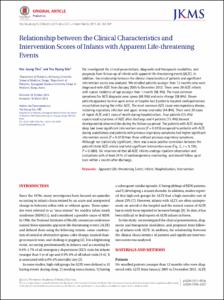Relationship between the Clinical Characteristics and Intervention Scores of Infants with Apparent Life-threatening Events
- Keimyung Author(s)
- Choi, Hee Joung; Kim, Yeo Hyang
- Department
- Dept. of Pediatrics (소아청소년학)
- Journal Title
- Journal of Korean Medical Science
- Issued Date
- 2015
- Volume
- 30
- Issue
- 6
- Abstract
- We investigated the clinical presentations, diagnostic and therapeutic modalities, and
prognosis from follow-up of infants with apparent life-threatening events (ALTE). In
addition, the relationship between the clinical characteristics of patients and significant
intervention scores was analyzed. We enrolled patients younger than 12 months who were
diagnosed with ALTE from January 2005 to December 2012. There were 29 ALTE infants
with a peak incidence of age younger than 1 month (48.3%). The most common
symptoms for ALTE diagnosis were apnea (69.0%) and color change (58.6%). Eleven
patients appeared normal upon arrival at hospital but 2 patients required cardiopulmonary
resuscitation during the initial ALTE. The most common ALTE cause was respiratory disease,
including respiratory infection and upper airway anomalies (44.8%). There were 20 cases
of repeat ALTE and 2 cases of death during hospitalization. Four patients (15.4%)
experienced recurrence of ALTE after discharge and 4 patients (15.4%) showed
developmental abnormalities during the follow-up period. The patients with ALTE during
sleep had lower significant intervention scores (P = 0.015) compared to patients with ALTE
during wakefulness and patients with previous respiratory symptoms had higher significant
intervention scores (P = 0.013) than those without previous respiratory symptoms.
Although not statistically significant, there was a weak positive correlation between the
patient’s total ALTE criteria and total significant intervention score (Fig. 2, r = 0.330,
P = 0.080). We recommend that all ALTE infants undergo inpatient observation and
evaluations with at least 24 hr of cardiorespiratory monitoring, and should follow up at
least within a month after discharge.
- Publisher
- School of Medicine
- Citation
- Hee Joung Choi and Yeo Hyang Kim. (2015). Relationship between the Clinical Characteristics and Intervention Scores of Infants with Apparent Life-threatening Events. Journal of Korean Medical Science, 30(6), 763–769. doi: 10.3346/jkms.2015.30.6.763
- Type
- Article
- ISSN
- 1011-8934
- Appears in Collections:
- 1. School of Medicine (의과대학) > Dept. of Pediatrics (소아청소년학)
- 파일 목록
-
-
Download
 oak-aaa-2961.pdf
기타 데이터 / 348.01 kB / Adobe PDF
oak-aaa-2961.pdf
기타 데이터 / 348.01 kB / Adobe PDF
-
Items in Repository are protected by copyright, with all rights reserved, unless otherwise indicated.